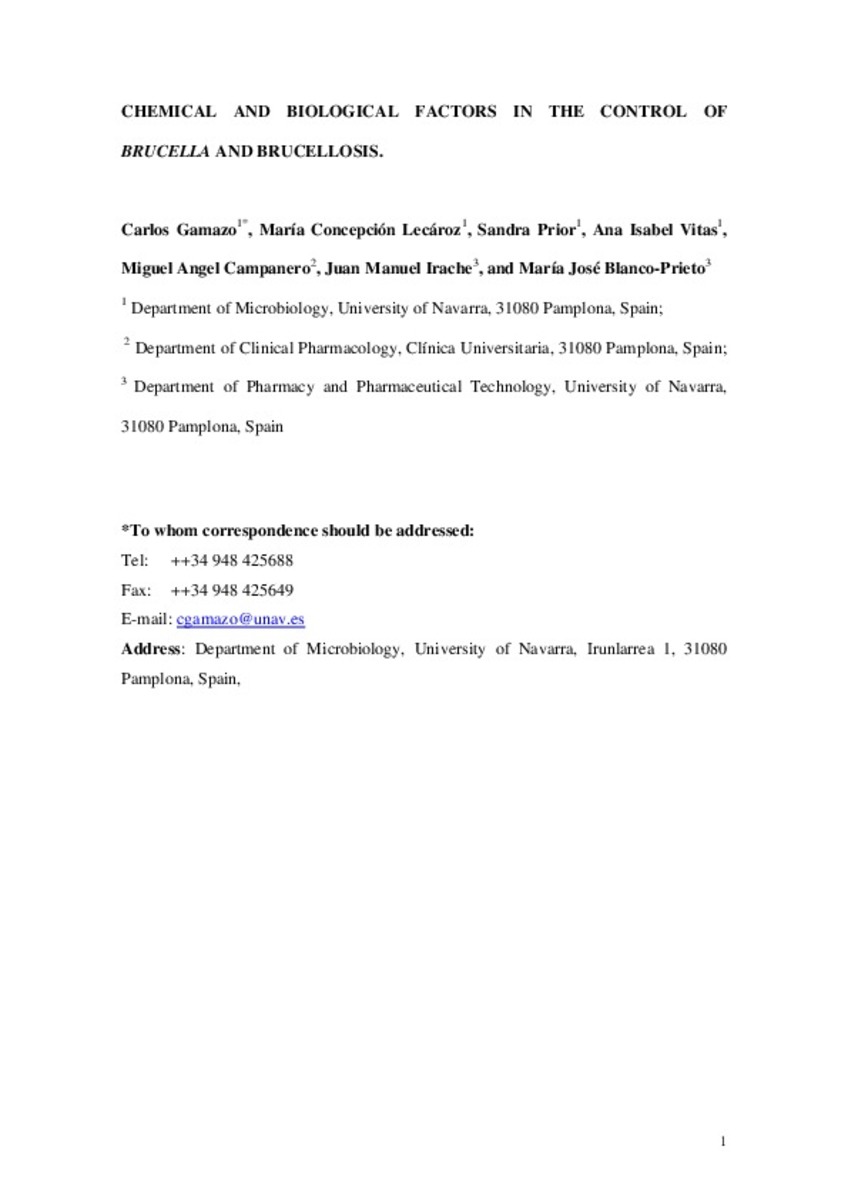Full metadata record
| DC Field | Value | Language |
|---|---|---|
| dc.creator | Gamazo, C. (Carlos) | - |
| dc.creator | Lecaroz, M.C. (María Concepción) | - |
| dc.creator | Prior, S. (Sandra) | - |
| dc.creator | Vitas, A.I. (Ana Isabel) | - |
| dc.creator | Campanero, M.A. (Miguel Angel) | - |
| dc.creator | Irache, J.M. (Juan Manuel) | - |
| dc.creator | Blanco-Prieto, M.J. (María José) | - |
| dc.date.accessioned | 2012-02-10T11:55:52Z | - |
| dc.date.available | 2012-02-10T11:55:52Z | - |
| dc.date.issued | 2006 | - |
| dc.identifier.citation | Gamazo C, Lecaroz MC, Prior S, Vitas AI, Campanero MA, Irache JM, et al. Chemical and biological factors in the control of Brucella and brucellosis. Curr Drug Deliv 2006 Oct;3(4):359-365. | es_ES |
| dc.identifier.issn | 1567-2018, | - |
| dc.identifier.uri | https://hdl.handle.net/10171/20802 | - |
| dc.description.abstract | Brucellosis is a highly contagious bacterial zoonosis that affects millions of people worldwide. Brucella is highly infectious, especially when aerosolized. The infection induces severe protracted diseases, which are both debilitating and incapacitating, hence, Brucella melitensis has been considered a potential biological warfare agent. In the battle against Brucella, it is crucial to know its chemical-structure and biochemistry-metabolic characteristics. It is well known that Brucella, as well as many other intracellular bacterial pathogens, has evolved to survive and even proliferate within monocytes and macrophages cells. Depending on the route of entry (complement, Fc, lectin or fibronectin receptors), the fate of the bacteria will vary; it may even segregate from the endocytic route towards the endoplasmic reticulum. This intracellular “non regular” behaviour of Brucella makes treatment difficult. Most antibiotics, although effective in vitro, do not actively pass through cellular membranes, or, once inside, may not reach the discrete intracellular niche where the bacteria is hidden. Therefore, complete eradication of the microorganisms is difficult to achieve, and the incidence of relapses is rather high. Taking these data into consideration, this review will evaluate the past, current and new trends in the control of brucellosis, paying special attention to the drug delivery systems as potential vectors for targeting these intracellular sites where the organisms are located. | es_ES |
| dc.language.iso | eng | es_ES |
| dc.publisher | Bentham Open | es_ES |
| dc.rights | info:eu-repo/semantics/openAccess | es_ES |
| dc.subject | Brucella | es_ES |
| dc.subject | Brucellosis | es_ES |
| dc.subject | Chemotherapy | es_ES |
| dc.subject | Gentamicin | es_ES |
| dc.subject | Drug delivery systems | es_ES |
| dc.title | Chemical and biological factors in the control Brucella and Brucellosis | es_ES |
| dc.type | info:eu-repo/semantics/article | es_ES |
| dc.relation.publisherversion | http://www.benthamdirect.org/pages/content.php?CDD/2006/00000003/00000004/003AP.SGM | es_ES |
| dc.type.driver | info:eu-repo/semantics/article | es_ES |
Files in This Item:
Statistics and impact
Items in Dadun are protected by copyright, with all rights reserved, unless otherwise indicated.






